SUMMARY
This is AI generated summarization, which may have errors. For context, always refer to the full article.

MANILA, Philippines – Only P337.5 million – not P828 million – from the 2015 budget for the health department’s Family Health and Responsible Parenting (FHRP) program can be used to procure family planning commodities in 2016.
Health Secretary Janette Garin clarified this in a press conference Wednesday, January 13 – a day after Senator Loren Legarda came out with her latest statement on the removal of a P1-billion allocation for contraceptives in the 2016 budget.
Legarda said that as of December 2015, the Department of Health (DOH) still has unobligated funds of P828 million under the FHRP program. But Garin said only P337.5 million from that amount can be used to buy family planning commodities such as condoms, pills, and IUDs.
Breakdown of P828 million:
- Implants (P337.5 million) – Shifted into procurement of cervical cancer vaccines
- Blood pressure apparatus – P337.5 million
- School-based immunization (HPV vaccine) – P153.8 million
The P337.5 million meant for the purchase of blood pressure apparatus for barangay health workers will now be used as the source of funds for contraceptives in 2016.
“Puwede pa hindi ipagpatuloy [yung purchase ng blood pressure apparatus]. Hindi naman maapektuhan kasi meron namang BP apparatus na kasalukyang binababa sa mga barangay,” the health secretary explained.
(We can afford not to continue for the meantime [the purchase of blood pressure apparatus]. It won’t affect the program because there are BP apparatus currently being brought to the villages.)
Garin assured the public that the P1-billion budget cut will not stop the department from fully implementing the RH law. In fact, they’re not worried for 2016. (READ: What happened to the 2016 budget for contraceptives?)
DOH’s family planning commodities for a certain year usually spill over until the first quarter of the next year. This means the department can still provide commodities until March.
The P337.5 million will be used for the 2nd and 3rd quarters of 2016, while there have been pledges from 3 foreign partners to assist the Philippine government for the rest of 2016.
The department is also looking for other sources of funds, including DOH savings identified and declared at the end of the year.
Garin also reiterated that the P1.67 billion which Legarda says is available in the 2016 budget is meant for other programs of the Family Health Office, and not for family planning.
The health chief hopes the budget cut will not happen again for the 2017 budget, because the first two quarters of next year will be critical.
“Dapat sa 2017, hindi na ito gawin kasi kung mangyari ulit ‘to sa 2017, magcocompile ang stockout, at babalik na naman tayo dun sa mga nanay na sana ay nakatake-off na ay ngayon mahihirapan ulit at babalik ‘yung kanilang paghihirap dahil sunod-sunod ang kanilang pagbubuntis,” she explained.
(This should not be done for 2017 because if this happens again in 2017, we will run out of stock and we would revert to the situation where mothers would have a difficult time due to having pregnancies one after the other.)
The secretary said Legarda has assured DOH she will make representations with the next president to allow the use of the department’s savings for the purchase of family planning commodities. (READ: Advocates on RH budget cut: ‘We’ve let our guard down’)
Not intentional?
Garin said that during the budget deliberations, the Senate already told them about other areas that need funds. They, in turn, gave the Senate a list of sources that can afford a decrease, such as allocations for trainings and seminars within the department.
Lawmakers instead removed the funds meant for the purchase of commodities.
“You have to admit, Congress and Senate have the power of the purse. Kung sa pananaw nila ay ‘di importante ang programa, may puder talaga silang tanggalin iyon. And that is also where the role of public and media comes into action – tayo may alam ng mga programang dapat huwag galawin,” she said.
(If they think that the program is not important, they have the power to remove it. And that is also where the role of public and media come into action. We know what programs should be left untouched.)
Since the P1 billion has already been removed from the budget, Garin said she would rather focus her efforts and time on finding ways to make sure the law is fully implemented.
“They were telling us na hindi siya intentional kasi yung nakita nila is commodities. Pero sabi namin, sana hindi sa commodities nagbawas, kasi ‘di mo pwedeng galawin budget…. We really wouldn’t touch the budget on commodities – as is dapat yun. Kung kukuha man kami, naghahanap kami ng budget dun sa iba na walang impact, na ‘di makakaepekto sa intention mong targets sa kalusugan,” she said.
(There were telling us that it’s not intentional because what they saw was commodities. But we told them, we wished there was no reduction in commodities because you can’t touch the budget….We really wouldn’t touch the budget on commodities – it should be as is. If we have to get elsewhere, we would look for items that would have no impact, that would not affect our targets in terms of health.) – Rappler.com
Add a comment
How does this make you feel?
There are no comments yet. Add your comment to start the conversation.